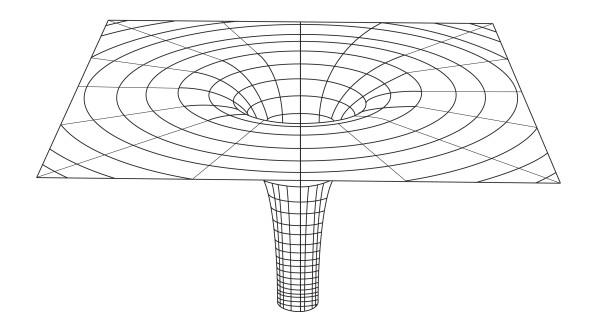“In physics, you don’t have to go around making trouble for yourself — nature does it for you.” -Frank Wilczek
Freedom is an easy thing for almost all the particles we think of. Want a free photon? Just let it go in a place where there's nothing that's going to absorb it. A free electron? Just keep it from binding to a proton and you're good. Even a free star or planet is possible, so long as you're willing to get far enough away from a gravitational source it might fall into.
 Image credit: The browser-crashing http://hortenseardalan.com/blackholes.html.
Image credit: The browser-crashing http://hortenseardalan.com/blackholes.html.
But a free quark? Impossible! In fact, it's impossible to have any sort of free particle that's charged under the strong interactions: that has a net color charge.
 Image credit: York Schröder, via http://www.physik.uni-bielefeld.de/~yorks/www/teaching.html.
Image credit: York Schröder, via http://www.physik.uni-bielefeld.de/~yorks/www/teaching.html.
Why is this so? Come find out, and learn what won the Nobel Prize exactly ten years ago!

Gravity and electrostatic forces are in some way fungible or global. If I have a charge at some point P, and another opposite charge a short distance away, I can compute the effect an arbitrary distance away by summing the one over r squared forces separately, i.e. the electostatic force at any point is a linear superpostion of forces from all the charges in the universe. If I think about trying this for a strong force which grows exponentially with distance I'm going to have a big problem. Is the strong force somehow restricted in terms of which quarks it applies to? Would the virtual force throughout space otherwise be so powerful that meson/anti-mesons pairs would be popping up everywhere?
It doesn't seem the SNF works that way. I think the explanation is the that the size of field the SNF exerts is too small. The SNF seems to only go as far as the nucleus of an atom. Or else we would see more manifestations of this force at the macro scale. The field may get stronger the further away you get from a quark, but it must definitely have a "breaking point" distance where the energies describe needed to break the bond creates quarks to pair and balance the newly separated quarks and therefore in the universe you don't see this phenomenon manifest. Another interesting question to ask is if the SNF field strength drops to 0 at it's source (the quark) and get stronger as you get away from it; does that mean that quarks operate under a different motion than say classical particles like electrons which have a spin and move in paths? The only way I can imagine this is visualizing quarks bouncing back and forth like they are attached with rubber bands to each other.
What is actually happening is the SNF bonding the quarks creates a channel in the vacuum of space that pushes the gluon field apart which is constantly bubbling and moving through space/time. The further the quarks are apart, the more energy you need to keep the channel between them. Eventually so much energy has to be poured into the channel that it forms quarks and breaks the bond. also the field distance on the SNF is measured in billionths of an meter, therefore this effect doesn't extend beyond the boundary of a proton or neutron. This video, which is actually explaining how the Higgs-field works, actually goes through how quark bonding works as well and has not only a good explanation of this effect but a good visualization as to what is actually happening.
https://www.youtube.com/watch?v=Ztc6QPNUqls&list=UUHnyfMqiRRG1u-2MsSQLb…
I'd like to know more about what the physics described in this article implies about the quark-gluon plasma that is supposed to have existed for a few milliseconds after the Big Bang. Without some mention of that, it feels incomplete to me, because the understanding I gain from it is not coherent.
Adrian - just from the wikipedia entry, it seems pretty straightforward and analogous to a normal plasma* to me. If the average energy of the quarks is higher than the energy required overcome the strong nuclear force, they can separate. Just as in a regular plasma, which you get when the average energy of the electrons is higher than their (EM force) binding energy.
*The properties of the resulting plasma may not be analogous, but the basic "what does it mean for it to be a plasma" seems to to be parallel.
It's not that I can't see how to reconcile the two phenomena. Presumably, in a quark-gluon plasma, colourless particles are continuously forming and separating and quarks continously passed from one composite particle to another, so that a given quark is always bound to *something* even though that something is replaced by something else a moment later. As opposed to just whizzing about by themselves like particles in a regular plasma.
I just think a paragraph covering that material would have improved the article, by drawing me a more complete picture. As it was, I enjoyed it, and learned something, but didn't pass it on to others.